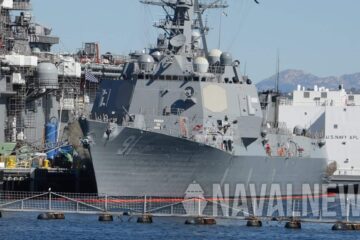The involved units are guided-missile cruiser USS Vella Gulf (CG 72) alongside USNS Benavidez, MV Resolve, and MV Patriot.
Sealift remains the primary method for transporting military equipment, supplies, and material around the world. With the return to peer competition and access to sea lanes no longer guaranteed, it is important that the U.S. Navy and MSC train together in order to ensure the successful delivery and sustainment of combat power necessary for the joint force to fight and win anywhere around the globe.
“In a real world conflict, much of the military equipment must still go by sealift, which makes convoy operations a critical skill set to maintain and practice. In the last five years, there has been an increased emphasis on including Merchant Marine shipping in large scale exercises to enhance tactical proficiency. Exercises that incorporate convoy operations are an extension of that ongoing tactical training.”
Capt. Hans E. Lynch, commodore Military Sealift Command Atlantic
This exercise will simulate an opposed transit, testing the fleets’ abilities to safely cross the Atlantic while testing new ways of conducting a convoy in today’s environment. Convoy operations were critical during WWI and WWII as the primary method for moving troops and military equipment, supplies and material to Europe. After WWII, convoys became less prevalent in the Atlantic theater, although still practiced in other areas of operation.

“The Atlantic is a battlespace that cannot be ignored. We need to be prepared to operate at the high end alongside our allies, partners and adversaries alike as soon as we’re underway.”
Vice Adm. Andrew Lewis, commander U.S. 2nd Fleet
During her operations in the Atlantic, Nimitz-class aircraft carrier USS Dwight D. Eisenhower (CVN 69), along with P-8s from VP-4 and a U.S. submarine, cleared the maritime battlespace prior to the transit of the Vella Gulf escorted MSC convoy.

“The coordination between NAVEUR, 2nd Fleet, and 6th Fleet are indicative of a seamless Atlantic Ocean. This exercise allows us to sharpen our ability to move critical resources across the Atlantic, from the United States to Europe. As I have said before, logistics is the sixth domain of warfare, and a critical part of any successful operation or exercise. The transatlantic bridge is just as important today for moving troops and military equipment, supplies and material from the United States to Europe as it has been at any point in history.”
Adm. James G. Foggo III, commander, NAVEUR







One Comment
Pingback : LES @MERS DU CESM – Assistant départemental pour la Marine du Haut-Rhin